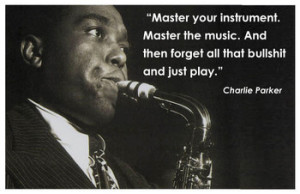“Graduated Linear Training For Improvisation”
“The less effort, the faster and more powerful you will be.”
– Bruce Lee
There have been many books written about the theory of jazz, the application of scales, modes, chord progressions, styles, and their historical origins. However, none touch on the spontaneous biomechanical feat of actually playing jazz. During the early days in the history of jazz there was an absence of established institutions and no method books to supplement the player with learning material. And yet, jazz developed quickly and spread respectively throughout the western hemisphere. Before 1960, musicians had minimal access to formal jazz training in public schools, colleges, and universities that are in place today. Jazz was learned primarily by:
- Exposure to the Idiom– Listening to jazz, live or records.
- Learning from a trusted source– Talking with accomplished professional jazz musicians.
- Consistent application– Playing jazz constantly. Prior to the emergence of Rock & Roll, Jazz was considered to be a form of “pop” music at the time. Players could develop their craft on practically every gig.
- Motivation- Playing to the best of your abilities – always. Players pushed themselves to excel because of competition, camaraderie, the desire to explore jazz to its fullest potential (which was a potent stimulus in itself), and to be rehired in order to eat and pay the rent.
- Self-Discipline- Required constant practice. Learning jazz was the sole responsibility of the aspiring jazz musician.
- Stimulation– Environment. Just being in a jazz center, IE: New York City. Playing with musicians equal or better than one self. Players couldn’t help but to absorb some knowledge of jazz just by exposure to other high caliber musicians/music and even lifestyle.
Most students and semi-professionals have limited opportunities to play: daily, for long periods of time, consistently, and with more advanced players. Jazz gigs are not nearly as abundant as they used to be. Having a rhythm section to aid your practicing sessions for as long as you desire is unrealistic.
The idea of the ‘Tao of Improvisation’ is to replicate the intensity of the playing environment in which the great masters developed their craft during the 1950’s every time they performed.


